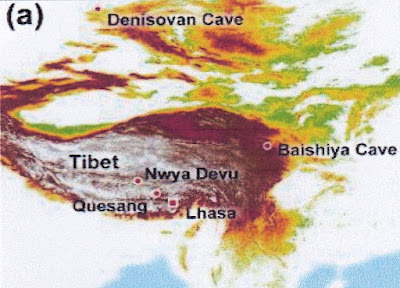One subject
of continual interest is the age of any example of art, particularly the
earliest (oldest) example of art. Previously, pieces of ocher from Blombos Cave
in South Africa had been claimed as the oldest example of petroglyphs in the
world. One fragment, which has been dated to ca. 100,000 years BCE, bears a
pattern of intentional scratch marks on the surface. On 25 August 2018, I wrote
of this “All students of this question
seem to share the assumption that the ocher was ground to make a pigment powder
that can be mixed into paint for other use. What the current debate seems to be
about is whether the designs on the ocher have any symbolic significance or
whether they were perhaps only doodles.” (Faris 2018) While they look to me
to have been created by scraping to get powdered ocher, they have been accepted
as human made marks, thus possibly the oldest petroglyph.
There are
always going to be questions about whether certain old traces of hominin
activity should be classified as art. This is particularly relevant when it
comes to recently described human hand and foot prints discovered in Tibet. By
the same logic applied to the Blombos cave ocher, if the Tibetan hand and foot
prints had been placed intentionally, ipso facto, they must be accepted as
petroglyphs. just as the mud glyphs of Tennessee caves, or as painted
handprints are accepted as pictographs.
Back in
2016 and 2017 I wrote a couple of columns on handprints and pictographs in
Tibet as being the highest (altitude above sea level) rock art known. The
handprints were reported from a location given as Chusang, which I assume is a
different spelling for the same place as this report, Quesang. They were actual
handprints in travertine limestone and were dated to approximately 7,400 years
BP. Now new dating of handprints at Quesang have given us much older dates. (Faris
2017)
“At Quesang on the Tibetan Plateau
we report a series of hand and foot impressions that appear to have been
intentionally placed on the surface of a unit of soft travertine. The
travertine was deposited by water from a hot spring which is now inactive and
as the travertine lithified it preserved the traces. On the basis of the sizes
of the hand and foot traces we suggest that two track-makers were involved and
were likely children. We interpret this event as a deliberate artistic act that
created a work of parietal art. The travertine unit on which the traces were
imprinted dates to between ~169 and 226 ka BP. This would make the site the
earliest currently known example of parietal art in the world and would also
provide the earliest evidence discovered to date for hominins on the High
Tibetan Plateau (above 4000 m a.s.l.).” (Zhang et al 2021)
This
particular area on the Tibetan plateau is supplied with a number of hot
springs, both active and fossilized. This particular location is one of the
fossilized hot springs.
Regional context for Quesang prints showing other hominin locales.
“We argue that these traces were imprinted into soft travertine (pre-lithification) and were not carved after the travertine had lithified. On the basis of Uranium series dating the travertine unit in which the tracks are impressed dates from between ~169 and 226 ka BP. Based on the size of the tracks the trackmakers were likely two children and the traces were not imprinted during normal locomotion or by the use of hands to stabilize motion as reported at the Rocomonfina track site in Italy. Consequently, we argue that the deliberate track-making was likely and early act of parietal art.” (Zhang et al:2021)
Five hand prints and five footprints were recorded on the travertine unit under study. The team compared measurements of the prints to the growth curves of modern humans. “A growth curve suggests that the track-maker was of equivalent size to a Homo sapiens child with a mean age of 7.75 ± 0.12 (years). The length to width ratio of the hands falls within the modern range, although the fingers are more elongated. The average hand length is 161.07 ± 2.72 mm, which equates to a child with a mean age of 12.17 ± 0.18 a, using a modern Homo sapiens growth curve.” (Zhang et al:2021)
While you may or may not be able to think of them as art per se, they do seem to have been intentionally made, and that intentionality to modify a surface, to leave a physical trace, is at the root of all artistic creation. These prints seem to be the earliest currently known so we must consider them to be the oldest known examples of art.
NOTE: Some images in this posting were retrieved from the internet with a search for public domain photographs. If any of these images are not intended to be public domain, I apologize, and will happily provide the picture credits if the owner will contact me with them. For further information on these reports you should read the original reports at the sites listed below.
REFERENCES:
Faris, Peter, 2018, Oldest Petroglyphs So Far?, 25 August 2018, https://rockartblog.blogspot.com/search/label/Blombos%20 cave
Faris, Peter, 2017, High Altitude Rock Art – Tibet Yet Again, 30 September 2017, https://www.blogspot.com
Zhang, David D. et al, 2021, Earliest Parietal Art: Hominin Hand and Foot Traces From the Middle
Pleistocene of Tibet, Science Bulletin (2021), DOI:
10.1016/j.scrib.2021.09.001









No comments:
Post a Comment